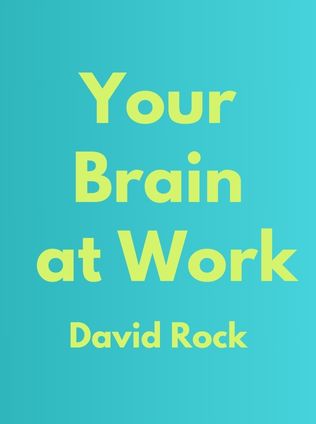
Your Brain at Work
Strategies for Overcoming Distraction, Regaining Focus, and Working Smarter All Day Long
By David Rock
Published 10/2009
About the Author
David Rock is a renowned figure in the field of neuroleadership, a term he coined to describe the application of neuroscience research to leadership practices. He co-founded the Neuroleadership Institute, which advises leaders from prominent organizations like NASA and IBM on how to improve their effectiveness by understanding the brain's natural rhythms and functions. Rock's work primarily targets people in leadership positions, but his strategies can apply to workers at any level, making his insights widely accessible and impactful.
Main Idea
In "Your Brain at Work," David Rock argues that by understanding the neuroscience behind how the brain functions, you can increase your productivity at work and optimize your efficiency and performance. Rock uses the extended metaphor of a theater to illustrate his ideas: the brain is the stage, thoughts are the audience, and actors perform his methods in hypothetical work scenarios. He organizes his strategies into five sections: energizing your brain, regulating your emotions, collaborating with coworkers, unblocking your creativity, and keeping your focus.
Table of Contents
- How to Energize Your Brain
- How to Regulate Your Brain’s Emotions
- How to Get Your Brain to Collaborate
- How to Reactivate Your Brain’s Creativity
- How to Focus Your Brain
How to Energize Your Brain
Today's work environment often requires a series of cognitive tasks that rapidly drain the brain's energy, decreasing productivity. Cognitive tasks occur in the prefrontal cortex, including complex processes like critical thinking, problem-solving, and planning. When performing a cognitive task, your brain summons a large, interconnected neural network that includes all related data. For example, if you’re planning a meeting, your brain retrieves protocols, memories of past meetings, and emotions tied to how well previous meetings went. When your brain is fully energized, sorting through your neural network is fast and easy. However, if you’re running low on energy, your brain struggles to focus on what’s important and can get distracted or overwhelmed with tangential information.
Rock argues that by understanding how cognitive tasks use energy, you can make predictions about what times of day will require the most energy and adequately prepare for them. Start your workday by prioritizing your tasks. Making to-do lists, scheduling, and other forms of prioritizing are high-order functions that demand a lot of energy from the prefrontal cortex. Sit down with your agenda at the very beginning of the workday when your energy is at its peak. Plan to work on your most important and energy-consuming task first. As you continue through your day, your energy will begin to fluctuate. Accomplishing an urgent or stressful task first will decrease potential anxiety later on and give you motivation to keep going.
Alternate high- and low-energy tasks. If possible, sandwich high-energy tasks between tasks that require less from your prefrontal cortex. For example, take a lunch break between two meetings or organize your office space before moving on to the next stage in your project. Manage your energy levels directly: if you notice your brain tiring during an important task or if you can't schedule a long break, try to increase your brain's current energy levels by replenishing your glucose and oxygen. Eat or drink something sweet to refuel on glucose, and take a walk or do some light exercise to refuel on oxygen.
Rock's advice on diet and exercise is also noteworthy. Nutritionists agree that carbohydrates are the best at replenishing glucose for energy. However, diets are very personal; health, money, allergies, and other factors determine what is best for a person to eat. In general, simple carbs that have added sugars, syrups, and white flour should be avoided when trying to gain energy. Better carbs for energy boosts are complex carbs found in barley, quinoa, whole grain cereals, and whole wheat bread. Additionally, sitting for long periods affects the circulation of oxygen to the brain. Health experts recommend taking short exercise breaks every 15-25 minutes. Transitioning to a standing desk or simple changes like stretching at your desk can keep your circulation working efficiently.
How to Regulate Your Brain’s Emotions
Rock explains that while cognitive tasks occur in the front of the brain, emotions are processed in the limbic system, located in the center regions of the brain. He classifies the signals we receive from our limbic system as "toward" and "away" emotions because they pull us emotionally either toward something or away from it. Toward emotions are positive feelings such as curiosity and happiness, which emit dopamine, serotonin, or oxytocin, giving us a boost of energy to complete a task. Away emotions are negative feelings like anxiety, fear, and sadness, which heighten our cortisol and adrenaline levels, making us want to avoid the task.
Sign up for FREE and get access to 1,400+ books summaries.
You May Also Like
The Subtle Art of Not Giving a F*ck
A Counterintuitive Approach to Living a Good Life
By Mark MansonRich Dad Poor Dad
What the Rich Teach Their Kids About Money - That the Poor and Middle Class Do Not!
By Robert T. KiyosakiHow To Win Friends and Influence People
The All-Time Classic Manual Of People Skills
By Dale CarnegieFreakonomics
A Rogue Economist Explores the Hidden Side of Everything
By Steven D. Levitt and Stephen J. Dubner



















